九年级英语(鲁教版)Unit_1_When_was_it_invented?检测题(含解析)
鲁教版(五四学制)九年级英语全一册:Unit 1 When was it invented?Sec
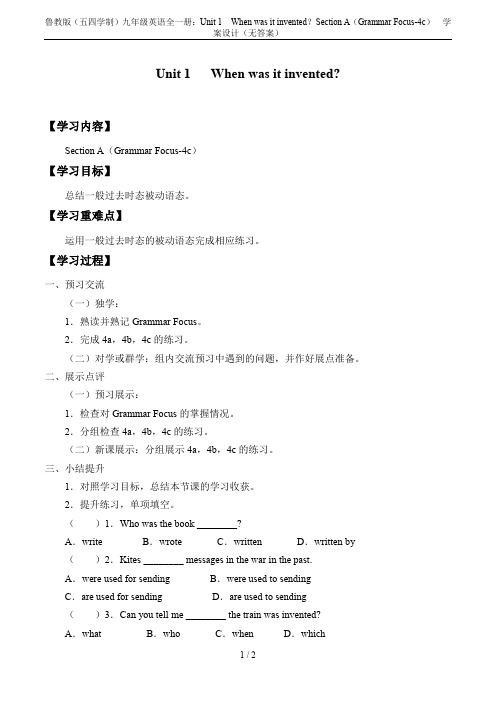
Unit 1 When was it invented?【学习内容】Section A(Grammar Focus-4c)【学习目标】总结一般过去时态被动语态。
【学习重难点】运用一般过去时态的被动语态完成相应练习。
【学习过程】一、预习交流(一)独学:1.熟读并熟记Grammar Focus。
2.完成4a,4b,4c的练习。
(二)对学或群学:组内交流预习中遇到的问题,并作好展点准备。
二、展示点评(一)预习展示:1.检查对Grammar Focus的掌握情况。
2.分组检查4a,4b,4c的练习。
(二)新课展示:分组展示4a,4b,4c的练习。
三、小结提升1.对照学习目标,总结本节课的学习收获。
2.提升练习,单项填空。
()1.Who was the book ________?A.write B.wrote C.written D.written by ()2.Kites ________ messages in the war in the past.A.were used for sending B.were used to sendingC.are used for sending D.are used to sending()3.Can you tell me ________ the train was invented?A.what B.who C.when D.which()4.—________ do you have a class meeting? —Once a week. A.How old B.How far C.How often D.How long ()5.—Excuse me, can I interview Mr. Miller this afternoon?—A moment, please. Let me check ________.A.if Mr. Miller will be free B.when will Mr. Miller have time C.if Mr. Miller had an appointment D.when does Mr. Miller come back ()6.________they are twins, they don't look the same at all. A.Because B.Though C.As D.Since()7.—Who helped Li Lei with his English?—________. He learnt it by himself.A.Anybody B.Somebody C.Nobody D.Everybody。
初中英语鲁教九年级Unit 1 When was it invented教学设计
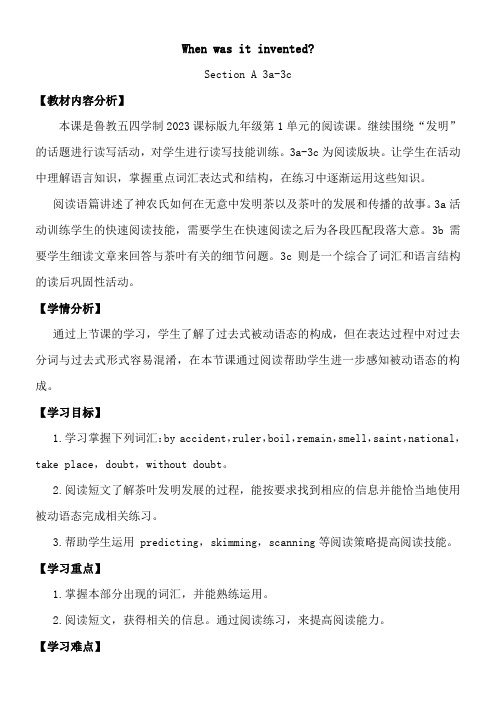
When was it invented?Section A 3a-3c【教材内容分析】本课是鲁教五四学制2023课标版九年级第1单元的阅读课。
继续围绕“发明”的话题进行读写活动,对学生进行读写技能训练。
3a-3c为阅读版块。
让学生在活动中理解语言知识,掌握重点词汇表达式和结构,在练习中逐渐运用这些知识。
阅读语篇讲述了神农氏如何在无意中发明茶以及茶叶的发展和传播的故事。
3a活动训练学生的快速阅读技能,需要学生在快速阅读之后为各段匹配段落大意。
3b需要学生细读文章来回答与茶叶有关的细节问题。
3c则是一个综合了词汇和语言结构的读后巩固性活动。
【学情分析】通过上节课的学习,学生了解了过去式被动语态的构成,但在表达过程中对过去分词与过去式形式容易混淆,在本节课通过阅读帮助学生进一步感知被动语态的构成。
【学习目标】1.学习掌握下列词汇:by accident,ruler,boil,remain,smell,saint,national,take place,doubt,without doubt。
2.阅读短文了解茶叶发明发展的过程,能按要求找到相应的信息并能恰当地使用被动语态完成相关练习。
3.帮助学生运用 predicting,skimming,scanning等阅读策略提高阅读技能。
【学习重点】1.掌握本部分出现的词汇,并能熟练运用。
2.阅读短文,获得相关的信息。
通过阅读练习,来提高阅读能力。
【学习难点】阅读短文,获得相关的信息,并运用被动语态谈论发明。
【教学环境及资源准备】搜集有关茶的资料、多媒体课件、学案。
【教学策略选择与设计】任务型教学法【课堂导学过程】【新课导入】Step 1: Lead-inTalk about tea with students. How many kinds of drinks do you know? Can you name some? What’s the most popular drink in the world? (Tea) How much do you know about tea? How many kinds of tea do you know?(环节说明:通过展示图片,利用学生熟悉的话题导入新课。
初中英语鲁教版(五四制)九年级全册Unit 1 When was it invented知识点

九年级英语全册Unit 1知识点【Section A】一、重点单词及短语1.electricity 电;电能;n.不可数例:The Three Gorges Dam produces electricity for millions of people in China.三峡大坝为数百万中国人发电。
[拓展]①electric 形容词,电力的;导电的;电动的;常作定语,指以电为动力进行工作的装置。
例:an electric car 一辆电动汽车② electrical 形容词,电的;与电有关的,表示与电有关的东西或研究电气科学等。
例:an electrical engineer2.style 样式;款式;方式;作风 n.the style of…意为“…的样式/风格”例:The style of the skirt is just in season.[拓展]常用短语:in style 意为“流行的;时髦的”out of style 意为“过时的”a life style 意为“生活方式”3.pleasure 愉快;高兴 n.不可数例:It gives me great pleasure to grow flowers.种花带给我很大的乐趣。
可数名词,快乐的事[拓展]pleased 形容词,高兴的,喜欢的,句子的主语通常是人。
例:We are very pleased with our new house.我们对我们的新房子很满意。
pleasant形容词,令人高兴的,令人愉快的,修饰事物。
例:I hope you have a pleasant trip.4.daily 每日的,日常的 adj.例:What is your daily work?[拓展]①daily 还可作名词,意为“日报”People’s Daily 《人民日报》 China Daily 《中国日报》②与daily 结构相似的词有:weekly 每周的 monthly 每月的 yearly 每年的5.list 列表;列清单 v.例:Please list all the things you want to buy.[拓展]list 用作可数名词,意为“名单;清单”短语:make a list 列清单例:You can make a list of things to do.6.mention 提到;说到 v.其后可接名词、代词、动词-ing 形式或 that 从句作宾语。
鲁教版英语九年级Unit 1 When was it invented? 教案
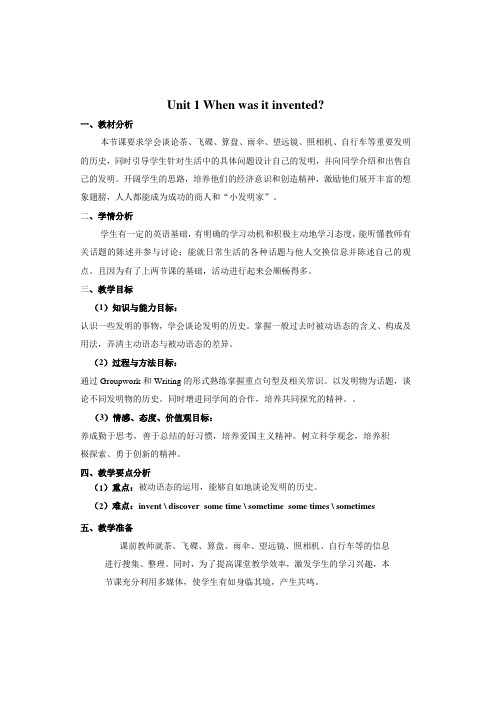
Unit 1 When was it invented?一、教材分析本节课要求学会谈论茶、飞碟、算盘、雨伞、望远镜、照相机、自行车等重要发明的历史,同时引导学生针对生活中的具体问题设计自己的发明,并向同学介绍和出售自己的发明。
开阔学生的思路,培养他们的经济意识和创造精神,激励他们展开丰富的想象翅膀,人人都能成为成功的商人和“小发明家”。
二、学情分析学生有一定的英语基础,有明确的学习动机和积极主动地学习态度,能听懂教师有关话题的陈述并参与讨论;能就日常生活的各种话题与他人交换信息并陈述自己的观点。
且因为有了上两节课的基础,活动进行起来会顺畅得多。
三、教学目标(1)知识与能力目标:认识一些发明的事物,学会谈论发明的历史。
掌握一般过去时被动语态的含义、构成及用法,弄清主动语态与被动语态的差异。
(2)过程与方法目标:通过Groupwork和Writing的形式熟练掌握重点句型及相关常识。
以发明物为话题,谈论不同发明物的历史。
同时增进同学间的合作,培养共同探究的精神。
(3)情感、态度、价值观目标:养成勤于思考,善于总结的好习惯,培养爱国主义精神。
树立科学观念,培养积极探索、勇于创新的精神。
四、教学要点分析(1)重点:被动语态的运用,能够自如地谈论发明的历史。
(2)难点:invent \ discover some time \ sometime some times \ sometimes五、教学准备课前教师就茶、飞碟、算盘、雨伞、望远镜、照相机、自行车等的信息进行搜集、整理。
同时,为了提高课堂教学效率,激发学生的学习兴趣,本节课充分利用多媒体,使学生有如身临其境,产生共鸣。
六、教具:多媒体、录音机七、教学过程Step I: ReviewMake dialogues like this:A: What is the invention?B: It’s a light bulb.A: When was it invented ?B: I think it was invented in 1879.A: Who was it invented by?B: It was invented by Thomas Edison.A: What is it used for ?B: It is used for giving people more time to work and play every day.car / 1885 / Henry Ford / travel fastfridge / 1862 / Harrison / keep food freshwashing machine / 1858 / Smith / wash clothes[设计意图] 通过此环节复习一下前面学过的句型,以及操练被动语态的基本句子结构,锻炼学生的口头表达能力。
鲁教版英语九年级Unit 1 When was it invented? 教案(2)
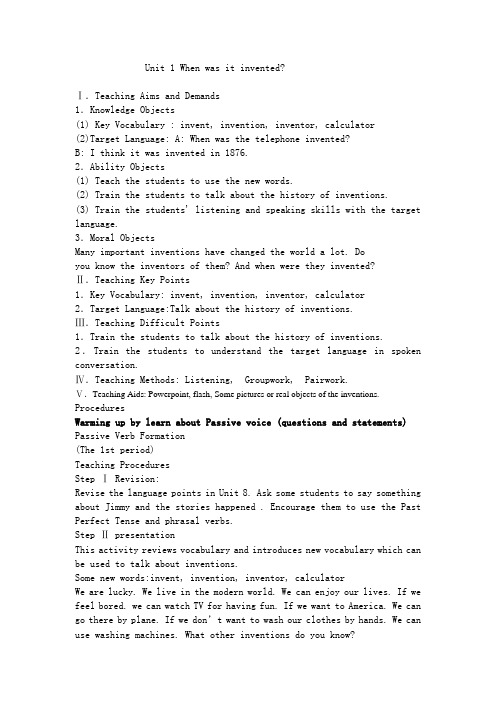
Unit 1 When was it invented?Ⅰ.Teaching Aims and Demands1.Knowledge Objects(1) Key Vocabulary : invent, invention, inventor, calculator(2)Target Language: A: When was the telephone invented?B: I think it was invented in 1876.2.Ability Objects(1) Teach the students to use the new words.(2) Train the students to talk about the history of inventions.(3) Train the students' listening and speaking skills with the target language.3.Moral ObjectsMany important inventions have changed the world a lot. Doyou know the inventors of them? And when were they invented? Ⅱ.Teaching Key Points1.Key Vocabulary: invent, invention, inventor, calculator2.Target Language:Talk about the history of inventions. Ⅲ.Teaching Difficult Points1.Train the students to talk about the history of inventions. 2.Train the students to understand the target language in spoken conversation.Ⅳ.Teaching Methods: Listening, Groupwork, Pairwork.Ⅴ.Teaching Aids: Powerpoint, flash, Some pictures or real objects of the inventions. ProceduresWarming up by learn about Passive voice (questions and statements) Passive Verb Formation(The 1st period)Teaching ProceduresStep Ⅰ Revision:Revise the language points in Unit 8. Ask some students to say something about Jimmy and the stories happened . Encourage them to use the Past Perfect Tense and phrasal verbs.Step Ⅱ presentationThis activity reviews vocabulary and introduces new vocabulary which can be used to talk about inventions.Some new words:invent, invention, inventor, calculatorWe are lucky. We live in the modern world. We can enjoy our lives. If we feel bored. we can watch TV for having fun. If we want to America. We can go there by plane. If we don’t want to wash our clothes by hands. We can use washing machines. What other inventions do you know?Call the students' attention to the five pictures. Point to each picture and let the students tell what it is.Have several different students guess and write the dates on their own books.Guess:Which one was invented earlier?I think the was invented before /after theAsk different students to answer the questions.Step Ⅲ Listening:This activity gives students practice in understanding the target language in spoken conversation.Call the students' attention to the five inventions in the picture. Ask five students to say the names of them. Then ask them to see the five dates with a blank line in front of each.Then play the recording again. Pause after each important sentence and let the students repeat.Step Ⅳ Pairwork:(1) This activity provides guided oral practice using the target language. Read the instructions and point to the list of dates in Activity 1b.You will be talking about the dates things were invented with a partner. Write the conversation on the blackboard. Then get the students to practice in pairs, using the information in Activity 1b. Ask several pairs to share their conversations with the class.(2) Give some inventions and inventors. make a dialogue use the following structures:A: Who was the _____ invented by ?B: It was invented by ______.A: What is it used for?B: It’s used for ________________get the students to practice in pairs, using the information given. Ask several pairs to share their conversations with the class.Step Ⅴ Groupwork:Give some inventions and inventors .Make a short play and a dialogue with following structures:When was …… invented ?Who was ……invented by ?What’s …… used for ?get the students to practice in groups, using the information given. Ask several groups to share their short plays and conversations with the class.Step Ⅵ HomeworkMake a survey. Find 4 inventions and look up When, Who and be usedfor .Period 2Step 1Warm-up1. Greetings.2. revision:Show some pictures of inventions and talk about them.A: What is it in English?B: It’s…A: When was it invented?B: It was invented…A: What is it used for?B: It is used for…Step 2practice1. Learn new words:useful, annoyingAsk students to give some examples to show what each word means. For example, A vacuum cleaner is helpful. A very loud truck is annoying.2. Pair work3a.Make a list of five helpful inventions and five annoying inventions. Then teacher can ask students to tell the reasons.T: Is the light bulb useful or annoying?S1:I think it’s useful.T: Why is it ?S1: Well, it gives people more time to work and play every day.3b.Discuss the opinions about some inventions with the partner like this: A: What do you think is the most helpful invention?B: I think the most helpful invention is the light bulb.A: Why is that?B: Well, it gives people more time to work and play every day.Step 3Consolidation and ExtensionGroup work4Imagine that you are alone on a tiny island. Choose five inventions you would like to have on the island with you. Tell the group what you chose and why.Maybe you can use the following drills.I’d like to have a …because I could…It’s used for…I think the most helpful invention is …But that’s not going help you leave the island. I think it would be better to leave…Step 4 ExercisesFill in the blanks with the words given:1.The work _______(finish)tomorrow morning.2.The books must______(give)back on time.3.I think the telephone _____ (invent) in 1876.4.Tea may _______(invent) by accident.5.The ruler _____(use )since I began my school life.6.The bikes are used for_____(ride)on.Step 5Sum upGo over the whole lessons.Step 6Homework1、句型转换。
2022鲁教版九年级英语When was it invented
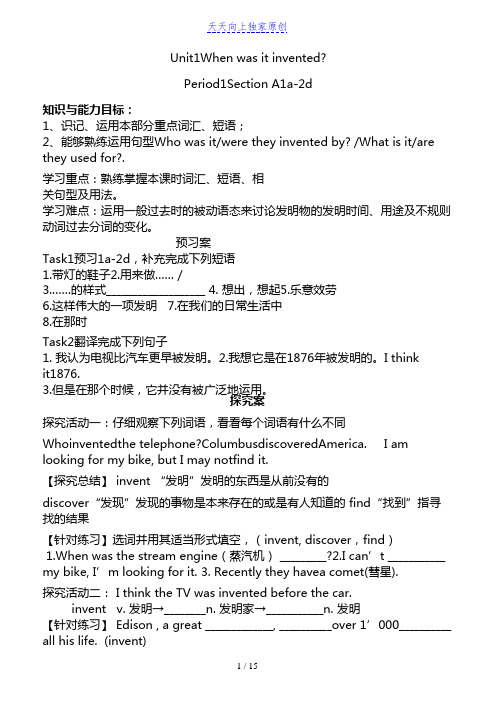
Unit1When was it invented?Period1Section A1a-2d知识与能力目标:1、识记、运用本部分重点词汇、短语;2、能够熟练运用句型Who was it/were they invented by? /What is it/are they used for?.学习重点:熟练掌握本课时词汇、短语、相关句型及用法。
学习难点:运用一般过去时的被动语态来讨论发明物的发明时间、用途及不规则动词过去分词的变化。
预习案Task1预习1a-2d,补充完成下列短语1.带灯的鞋子2.用来做…… /3.……的样式___________________4. 想出,想起5.乐意效劳6.这样伟大的一项发明7.在我们的日常生活中8.在那时Task2翻译完成下列句子1.我认为电视比汽车更早被发明。
2.我想它是在1876年被发明的。
I thinkit1876.3.但是在那个时候,它并没有被广泛地运用。
探究案探究活动一:仔细观察下列词语,看看每个词语有什么不同Whoinventedthe telephone?ColumbusdiscoveredAmerica. I am looking for my bike, but I may notfind it.【探究总结】 invent “发明”发明的东西是从前没有的discover“发现”发现的事物是本来存在的或是有人知道的 find“找到”指寻找的结果【针对练习】选词并用其适当形式填空,(invent, discover,find)1.When was the stream engine(蒸汽机) _________?2.I can’t ___________ my bike, I’m looking for it.3. Recently they havea comet(彗星).探究活动二: I think the TV was invented before the car.invent v. 发明→________n. 发明家→___________n. 发明【针对练习】 Edison , a great _____________, __________over 1’000__________ all his life. (invent)探究活动三:通过预习本节内容,你能写出被动语态的基本结构吗?一般现在时态的被动语态的基本结构一般过去时态的被动语态的基本结构训练案1.They set up this school last year.(改为被动语态)This school_________ _______ _______ by them last year.2. They grew tea plants here a few years ago. (改为被动语态) Tea plants here by them a few years ago.3. He brought his homework to school very late. (改为被动语态) His homeworkto school very late.4. The telephone was invented by Bell in 1876. (改为一般疑问句) _______ the telephone by Bell in 1876?5. I was asked to go to her welcome party. (改为否定句)I to go to her welcome party.达标案一、根据首字母或汉语提示完成单词,使句意完整。
鲁教版九年级英语Unit1 When was it invented 教案
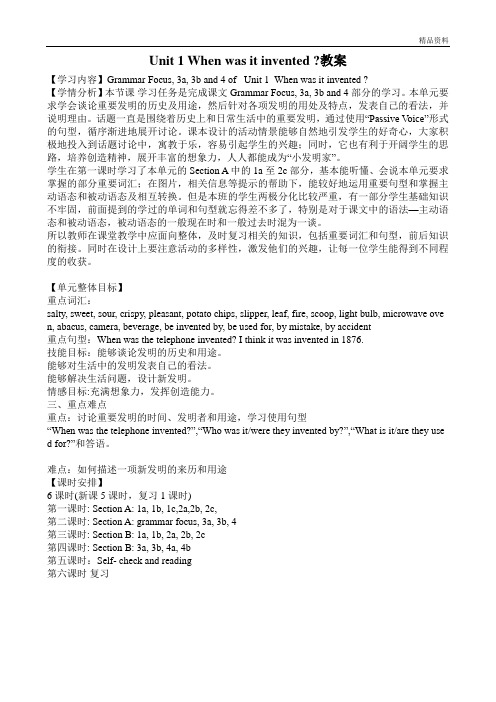
Unit 1 When was it invented ?教案【学习内容】Grammar Focus, 3a, 3b and 4 of Unit 1 When was it invented ?【学情分析】本节课学习任务是完成课文Grammar Focus, 3a, 3b and 4 部分的学习。
本单元要求学会谈论重要发明的历史及用途,然后针对各项发明的用处及特点,发表自己的看法,并说明理由。
话题一直是围绕着历史上和日常生活中的重要发明,通过使用“Passive V oice”形式的句型,循序渐进地展开讨论。
课本设计的活动情景能够自然地引发学生的好奇心,大家积极地投入到话题讨论中,寓教于乐,容易引起学生的兴趣;同时,它也有利于开阔学生的思路,培养创造精神,展开丰富的想象力,人人都能成为“小发明家”。
学生在第一课时学习了本单元的Section A 中的1a至2c部分,基本能听懂、会说本单元要求掌握的部分重要词汇;在图片,相关信息等提示的帮助下,能较好地运用重要句型和掌握主动语态和被动语态及相互转换。
但是本班的学生两极分化比较严重,有一部分学生基础知识不牢固,前面提到的学过的单词和句型就忘得差不多了,特别是对于课文中的语法—主动语态和被动语态,被动语态的一般现在时和一般过去时混为一谈。
所以教师在课堂教学中应面向整体,及时复习相关的知识,包括重要词汇和句型,前后知识的衔接。
同时在设计上要注意活动的多样性,激发他们的兴趣,让每一位学生能得到不同程度的收获。
【单元整体目标】重点词汇:salty, sweet, sour, crispy, pleasant, potato chips, slipper, leaf, fire, scoop, light bulb, microwave ove n, abacus, camera, beverage, be invented by, be used for, by mistake, by accident重点句型:When was the telephone invented? I think it was invented in 1876.技能目标:能够谈论发明的历史和用途。
鲁教版英语九年Unit 1 When was it invented Section B 1a-2e

鲁教版英语九年Unit 1 When was it invented Section B 1a-2e 教学设计一. 教材分析鲁教版英语九年级Unit 1的主题是“When was it invented?”,Section B 1a-2e部分主要介绍了几种日常用品的发明时间以及它们的用途。
本节课的主要语言目标是让学生能够运用过去时态描述物品的发明时间,以及能够介绍物品的用途。
本节课的内容与学生的生活息息相关,能够激发学生的学习兴趣。
二. 学情分析九年级的学生已经掌握了基本的英语语法和词汇,具备一定的听、说、读、写的能力。
他们对日常用品的种类和用途有一定的了解,因此在学习本节课时能够较快地理解和掌握知识点。
但部分学生对过去时态的运用还不够熟练,需要在课堂上进行针对性的操练和巩固。
三. 教学目标1.知识目标:学生能够掌握表示过去时态的句子结构,如“When was itinvented?”和“It was invented in…”。
2.能力目标:学生能够在适当的情境下运用过去时态描述物品的发明时间,并介绍其用途。
3.情感目标:通过学习,学生能够认识到科技的发展对人类生活的影响,培养他们对科技创新的兴趣。
四. 教学重难点1.重点:学生能够运用过去时态描述物品的发明时间。
2.难点:学生能够在实际情境中正确运用过去时态,并介绍物品的用途。
五. 教学方法1.情境教学法:通过设定情境,让学生在实际语境中学习和运用过去时态。
2.任务型教学法:通过完成小组任务,让学生在合作中练习和巩固语言知识。
3.交际法:通过师生互动和生生互动,提高学生的口语表达能力。
六. 教学准备1.准备相关日常用品的图片和视频资料。
2.设计教学活动和学习任务。
3.准备过去时态的练习题和答案。
七. 教学过程1.导入(5分钟)利用图片和视频展示几种日常用品,如手机、电视、电脑等,引导学生谈论这些物品的用途。
2.呈现(5分钟)展示课文中的1a-2e部分,让学生阅读并根据图片和文字回答问题。
鲁教版九年级英语unit1-When-was-it-invented?第一课时
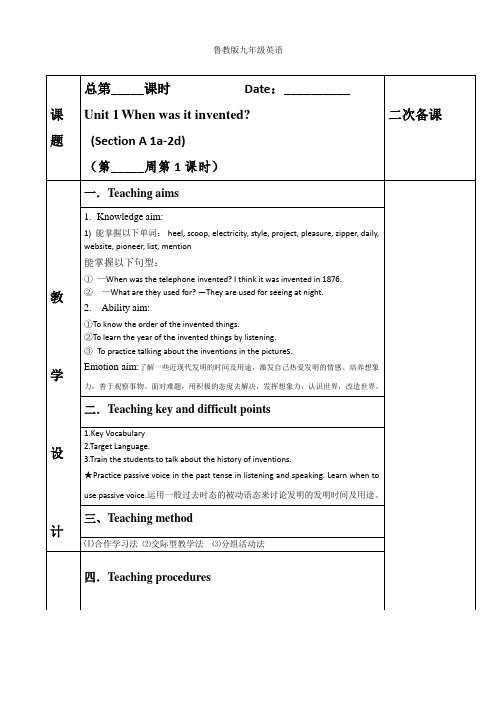
Step 4: Presenting(Pairwork 1C)
1. Ss try to remember the invention and the year.
2. Student B, cover the dates. Student A, ask Student B when the things in the picture in 1b were invented. Then change roles and practice again.
2. Play the recording for the Ss to listen and number the pictures.
3. Play the recording again to check the answers.
Work on 2b:
1. Let Ss read the chart below. Explain some main sentences for the Ss. Make sure they know what to do.
2. Discuss in groups and number them 1-5.
3. Check the answers.
Step 3: Listening 1b
①Read the instructions .②Play the recording for the first time.
③Check the answers with the whole class.④Play the recording a second time.
鲁教版九年级英语Unit1-When-was-it-invented?第五课时
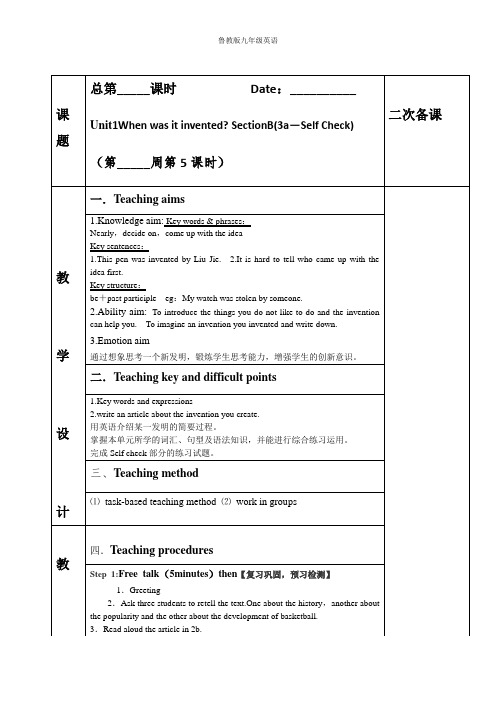
e.g. Problem: quickly taking notes in class.
2. Discuss in group and think of an invention that could help you.
用英语介绍某一发明的简要过程。
掌握本单元所学的词汇、句型及语法知识,并能进行综合练习运用。
完成Self check部分的练习试题。
三、Teaching method
⑴task-based teaching method⑵work in groups
教
学
设
计
四.Teaching procedures
Step 1:Free talk(5minutes)then【复习巩固,预习检测】
Key structure:
be+past participle eg:My watch was stolen by someone.
2.Ability aim:To introduce the things you do not like to do and the invention can help you. To imagine an invention you invented and write down.
Task 1:Work on Self Check 1:
①Read and review the words in the box.
②Fill in the blanks on their own. The teacher walks around.
③In pairs,correct the work of each other.
鲁教版九年级英语Unit-1-When-was-it-invented第二课时

一、播放视频《茶叶的起源》,让学生们了解中国的茶文化,及茶叶被发明的渊源,并了解其发展过程。
1. What is the video about? 2. Who is the writer of Cha Jing?
Ss try to answer the questions: It’s about the tea. Lu Yu.
2.Ability aim:1.To learn and understand the invention of tea.
2.To better understand the information about tea and Shen Nong.
1.Emotion aim
培养想象力,善于观察事物。了解中国茶历史和文化,提高文化底蕴。
Step 3: Listening and fast reading
Work on 3a:
1. Tell Ss to read the article quickly and match each paragraph with its main idea.
Para. 1
Para. 2
Para. 3
Ss read the article after the recording quickly and match each paragraph with its main idea.
Step 4:careful readingWork on 3b
Ask Ss to read the passage again and answer some questions.2.get Ss to answer the questions 3.check and corret the answers with the whole class.
新鲁教版九年级第一单元知识点归纳
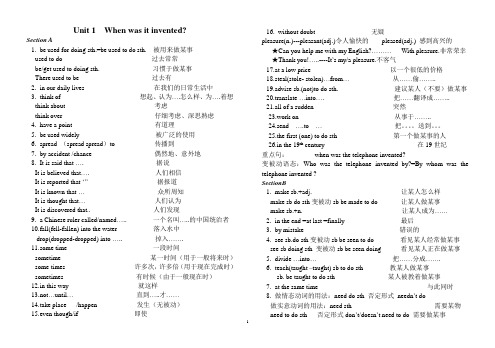
Unit 1 When was it invented?Section A1.be used for doing sth.=be used to do sth. 被用来做某事used to do 过去常常be/get used to doing sth. 习惯于做某事There used to be 过去有2.in our daily lives 在我们的日常生活中3.think of 想起、认为….怎么样、为….着想think about 考虑think over 仔细考虑、深思熟虑4.have a point 有道理5.be used widely 被广泛的使用6.spread (spread spread)to 传播到7.by accident /chance 偶然地、意外地8.It is said that …. 据说It is believed that…. 人们相信It is reported that ‘’’据报道It is known that …众所周知It is thought that…人们认为It is discovered that.. 人们发现9.a Chinese ruler called/named….. 一个名叫…..的中国统治者10.f all(fell-fallen) into the water 落入水中drop(dropped-dropped) into ….. 掉入…….11.s ome time 一段时间sometime 某一时间(用于一般将来时)some times 许多次,许多倍(用于现在完成时)sometimes 有时候(由于一般现在时)12.i n this way 就这样13.n ot…until…直到…..才……14.t ake place /happen 发生(无被动)15.e ven though/if 即使16.without doubt 无疑pleasure(n.)---pleasant(adj.)令人愉快的pleased(adj.) 感到高兴的★Can you help me with my English?………___With pleasure.非常荣幸★Thank you!…..----It’s my/a pleasure.不客气17.a t a low price 以一个很低的价格18.s teal(stole- stolen)…from…从……偷……..19.a dvise sb.(not)to do sth. 建议某人(不要)做某事20.t ranslate …into…. 把……翻译成……..21.a ll of a sudden 突然23.work on 从事于……..24.send ….to …把。
鲁教版英语(五四制)九年级_Unit1_核心必备句型详解
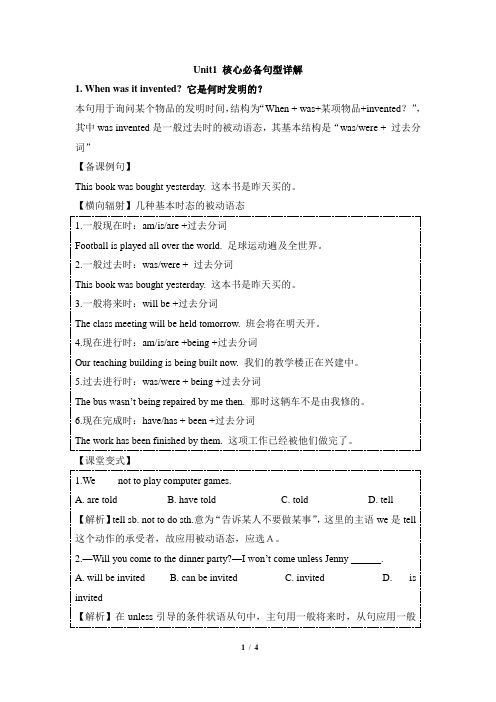
Unit1 核心必备句型详解1. When was it invented? 它是何时发明的?本句用于询问某个物品的发明时间,结构为“When + was+某项物品+invented?”,其中was invented是一般过去时的被动语态,其基本结构是“was/were + 过去分词”【备课例句】This book was bought yesterday. 这本书是昨天买的。
【横向辐射】几种基本时态的被动语态1.一般现在时:am/is/are +过去分词Football is played all over the world. 足球运动遍及全世界。
2.一般过去时:was/were + 过去分词This book was bought yesterday. 这本书是昨天买的。
3.一般将来时:will be +过去分词The class meeting will be held tomorrow. 班会将在明天开。
4.现在进行时:am/is/are +being +过去分词Our teaching building is being built now. 我们的教学楼正在兴建中。
5.过去进行时:was/were + being +过去分词The bus wasn’t being repaired by me then. 那时这辆车不是由我修的。
6.现在完成时:have/has + been +过去分词The work has been finished by them. 这项工作已经被他们做完了。
【课堂变式】1.We ____not to play computer games.A. are toldB. have toldC. toldD. tell【解析】tell sb. not to do sth.意为“告诉某人不要做某事”,这里的主语we是tell 这个动作的承受者,故应用被动语态,应选A。
鲁教版九年级英语《Unit1 When was it invented》教案1
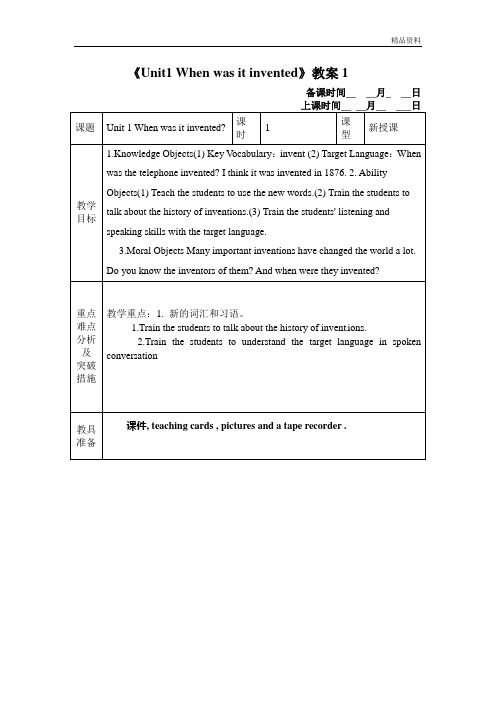
《Unit1 When was it invented》教案1备课时间__ __月_ __日课题Unit 1 When was it invented? 课时1课型新授课教学目标1.Knowledge Objects(1) Key V ocabulary:invent (2) Target Language:When was the telephone invented? I think it was invented in 1876. 2. Ability Objects(1) Teach the students to use the new words.(2) Train the students to talk about the history of inventions.(3) Train the students' listening and speaking skills with the target language.3.Moral Objects Many important inventions have changed the world a lot. Do you know the inventors of them? And when were they invented?重点难点分析及突破措施教学重点:1. 新的词汇和习语。
1.Train the students to talk about the history of invent ions.2.Train the students to understand the target language in spoken conversation教具准备课件, teaching cards , pictures and a tape recorder .板书设计Unit 1When was it invented? Section Bcrispy ( hard, dry an d easily broken) by mistakesourchef(cook)…salty (sprinkled with lots of salt) sprinkle.. onA: Did you know potato chips were invented by mistake?B: Wow, I didn’t know that. Who invented them?A: They were invented by a chef called George Crum .B: …教学过程(包括导引新课、依标导学、异步训练、达标测试、作业设计等)Step1 BrainstormingPlay guessing games: what inventions are they?One student comes to the front to guess, the others describe an invention shown on the screen using the passive sentences: It’s used for… It was invented by…It was invented in…etc.Take turns to show ‘light bulb, alarm clock, microwave oven’with some other helpful pictures that center about them nearby on the screen.(Purpose of desi gning: To guide the students to review what they learned last lesson)Step2 Leading-inT: The microwave oven reminds me of some delicious food. I will play a cartoon called “music food” My favorite food is in it. Try to guess what it is.Every time when they give a guess, I will express my like and dislike by using some adjectives like sweet, crispy, salty, sour . Make sure they know the meanings of them. For example:S:ChocolateT: It’s very crispy, but it’s too sweet. I don’t like it Can you guess the meaning of ‘crispy’? It describes food that is hard .dry and easily broken.S :Milk.T:I prefe r sour milk to milk. Do you know ‘sour’? Oranges sometimes taste sour.S: Fish.T: yes! Fish is my favorite, and I especially like salty fish that is sprinkled with a lot of salt.During this course, write down the new words on the blackboard..Finally play a leading role to read them.(Purpose :To arouse the students’ interest ,create useful situations for them to learn the new words.Prepare for the next step. )Step3 PracticeTask One writing1a.Show four food pictures on the screen and get the students to describe how th e food tastes and write them down.1b.Ask them to list the words of the food that has different tastes according to the headings on the screen as many as possible .sweet crispy salty sour The teacher moves around the classroom to provide help for the students who have trouble in spelling some hard words and choose three students who write different words from one another.(Purpose: To practice using the target words and review the food words they have learntbefore.)Task Two Speaking and actingGet the three students to the front, divide the class into four groups:Sweet Group , Crispy Group, Salty Group , Sour Group Game begins: The three students read their words loudly in class one by one without repetition, the group members should stand up as soon as they hear a word that belongs to them. Call out the students who stood up by mistake and have them guess the meaning of ‘by mistake’.(Purpose: This is employed to show the words they wrote and link the target words with the food words, and get the whole class moving.)esentationT: Just now you mentioned many kinds of food, bu t do you know there are some interesting stories behind them. Here is one.Ask the st udents to look at the picture in 2a and imagine what they are talking about.S: They are talking about the story of potato chips.T: Right .Maybe on the bag it says the invention of them!(Purpose: Cultivate their ability of imagination and present the invention of potato chips.)Step5 PracticeTask One Listening and understanding2a. Let the students look through the six sentences in the box and get some information from them. Then play the tape recording twice for them to listen and circle T or F. Check the answers.(Purpose: To provide practice in listening and understanding the target language in spoken conversation.)Task Two Listening and writing2b. Before playing the recording, get the stu dents to try to give answers by memory, or just by guessing. After a while, play the recording for them to fill in the missing words they hear. Then check the answers while concentrating on the new words: chef, sprinkle…on…(Purpose: To provide practice in understanding and writing the target language ,break through the difficult point.)Task Three Pairwork2c.Ask the students to make conversations using the information in 2a and 2b ,then ask some pairs to act them out. as follows:A: Did you know potato chips were invented by mistake?B: Wow, I didn’t know that. Who invented them?A: They were invented by a chef called George Crum.B: …(Purpose:Students are willing to show themselves and this task provides benefits for both more fluent and less fluent students to use the new language to talk with others and achieve the ability aim.)Task Four GroupworkT: Are you interested in the history of the sandwich?Show some pictures about the story of sandwiches on the screen, get them to discuss the history in groups of four as follows:Who…by?Where…?How…?Invention When was itinvented?the sandwichThen each group choose a leader to give a report in class after that .(Purpose: This is employed to do further consoli dation and extension using the target language, it also fosters a sense of cooperation in the classroom.)Step6 HomeworkT: Think of a kind of food you like best and try an unusual way to cook at home and write your experience in your exercise book. And ask your parent to sign his/her name on your bo ok.(Purpose: The new type of homework is employed to relate the knowledge that they learn from this lesson with the life realities, and achieve the moral aims.)。
鲁教版英语九年级Unit 1 When was it invented?学案(1)
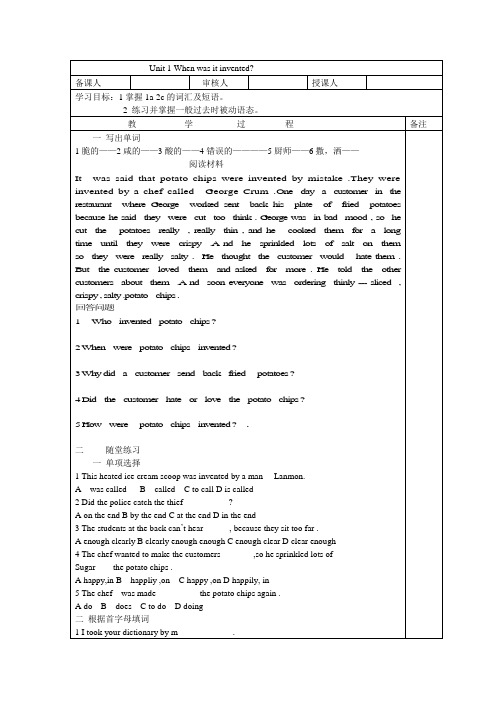
Unit 1 When was it invented?备课人审核人授课人学习目标:1掌握1a-2c的词汇及短语。
2 练习并掌握一般过去时被动语态。
教学过程备注一写出单词1脆的——2咸的——3酸的——4错误的————5厨师——6撒,洒——阅读材料It was said that potato chips were invented by mistake .They were invented by a chef called George Crum .O n e d ay a c u st o m er i n t h e restaur ant where Geor g e work ed sent ba ck his p late of fried p otatoe s becau se he sa id the y w e r e c u t t o o t h i n k . G eo r g e w a s i n b a d m o o d , so h ecut the potato es re all y , really thin , an d he cooked them for a longtime until t hey w ere crispy .A nd he spri nkled lot s of sal t on themso th ey w ere r eally salty . He thoug ht th e cu stomer would h ate them .But th e custom er lo ve d them an d asked fo r more .He told the othe r custom ers abo ut them .A nd soon everyon e w as orderin g t h i n l y---sl i c e d,crispy , salty .potato chip s .回答问题1 Who inven ted pot at o ch ips ?2 When w ere potat o c hips invented ?3 Why did a customer send b ack fried potat oes ?4 Did the cu stomer h at e or lov e the pot ato chips ?5 How were potato c hips inve nted ?.二随堂练习一单项选择1 This heated ice cream scoop was invented by a man __Lanmon.A was calledB calledC to callD is called2 Did the police catch the thief __________?A on the endB by the endC at the endD in the end3 The students at the back can’t hear______, because they sit too far .A enough clearlyB clearly enough enoughC enough clearD clear enough4 The chef wanted to make the customers_______ ,so he sprinkled lots ofSugar ___ the potato chips .A happy,inB happliy ,onC happy ,onD happily, in5 The chef was made _________ the potato chips again .A doB doesC to doD doing二根据首字母填词1 I took your dictionary by m____________ .2 The milk is s_______ .You can’t drink it any more .3 Mum added salt to the soup , but it wasn’t s_________ enough .4 Do you know the movie star c______ Liu Ruoying ?5 P__________ are used for making potato chips .三用正确单词填空。
九年级英语(鲁教版)Unit_1_When_was_it_invented?检测题(含解析)

Unit 6 When was it invented?检测题附详细参考答案和听力材料(时间:60分钟;满分:100分)一、听力部分(满分20分)Ⅰ. 听句子,选择正确的应答语。
每个句子读一遍。
(每小题1分,满分5分)1. A. By George Crum. B. In 1863.C. They are crispy.2. A. It’s used for calculating. B. It’s a great invention.C. By the Chinese.3. A. Because it’s too sweet. B. I li ke the colour.C. Would you like some?4. A. No, thank you. B. Good idea.C. It’s my pleasure.5. A. No, it isn’t. B. I’m sorry.C. Yes, it was.Ⅱ. 听短对话,选择正确的答案。
每段对话读两遍。
(每小题1分,满分5分)6. Who is not here?A. The teacher.B. Lucy.C. Jack.7. Does Jack watch TV every evening?A. Yes, he does.B. No, he doesn’t.C. It’s bad for his health.8. What’s wrong with Lily?A. She can’t swim.B. She can’t walk.C. She can’t wait.9. What would the two men like to do together?A. They’d like to play tennis.B. They’d like to go swimming.C. They’d like to play basketball.10. How does the woman want to go to the police station?A. By bus.B. By taxi.C. On foot.Ⅲ. 听长对话和问题,选择最佳答案。
【最新】鲁教版九年级英语Unit1 When was it invented? 精品课件.ppt

--Who was ... invented by? --It was invented by... --What is it used for? --It is used for...
Benz
travelling
a.
Noiman getting information
b.
Baird
relaxing
grammar:
一般现在时态被动语态构成:am/is/are+done
一般过去时态被动语态构成:was/were+done
Notes:1. 不知动作执行者时,常用被动语态. 2. 不必要说出动作执行者时,常用. 3. 为了突出强调动作的承受者时,常用被动语态.
1.( A) When _____ the car ______?
。2020年12月17日星期四2020/12/172020/12/172020/12/17
the door?
A. used, open B. used, opened
e, open D. used, opening
As long as you can think it, as long as you can act it, anybody can be a great inventor.
• 9、春去春又回,新桃换旧符。在那桃花盛开的地方,在这醉人芬芳的季节,愿你生活像春天一样阳光,心情像桃花一样美丽,日子像桃子一样甜蜜。 2020/12/172020/12/17Thursday, December 17, 2020
• 10、人的志向通常和他们的能力成正比例。2020/12/172020/12/172020/12/1712/17/2020 9:43:42 AM • 11、夫学须志也,才须学也,非学无以广才,非志无以成学。2020/12/172020/12/172020/12/17Dec-2017-Dec-20 • 12、越是无能的人,越喜欢挑剔别人的错儿。2020/12/172020/12/172020/12/17Thursday, December 17, 2020 • 13、志不立,天下无可成之事。2020/12/172020/12/172020/12/172020/12/1712/17/2020
鲁教版九年级英语Unit-1--When-was-it-invented?第三课时

③Ask some students:Do you like lemon?How about its taste?
Is the apple sweet?…
Step 3:listeningFinish the task in 1c
Step5: Homework
1.Make conversations with other students talking about how potato chips were invented after class.
1)掌握本课时出现的生词及用法。2)进行听力训练,提高综合听说能力。
2)听力训练4)阅读2b部分的短文并完成相关要求。
★Learn more participle verbs to say the passive voice.How to understand and talking about the invention of potato chips.
①Look at the sentences in 1c.Predict what we are going to hear.
②Play the recording for the first time. Students listen and try to get the rough meaning. ③Play the recording for the second time and students circle T or F.
课题
总第_____课时Date:__________
Unit1 When was it invented?Section B(1a-1e)
- 1、下载文档前请自行甄别文档内容的完整性,平台不提供额外的编辑、内容补充、找答案等附加服务。
- 2、"仅部分预览"的文档,不可在线预览部分如存在完整性等问题,可反馈申请退款(可完整预览的文档不适用该条件!)。
- 3、如文档侵犯您的权益,请联系客服反馈,我们会尽快为您处理(人工客服工作时间:9:00-18:30)。
Unit 6 When was it invented?检测题附详细参考答案和听力材料(时间:60分钟;满分:100分)一、听力部分(满分20分)Ⅰ. 听句子,选择正确的应答语。
每个句子读一遍。
(每小题1分,满分5分)1. A. By George Crum. B. In 1863.C. They are crispy.2. A. It’s used for calculating. B. It’s a great invention.C. By the Chinese.3. A. Because it’s too sweet. B. I li ke the colour.C. Would you like some?4. A. No, thank you. B. Good idea.C. It’s my pleasure.5. A. No, it isn’t. B. I’m sorry.C. Yes, it was.Ⅱ. 听短对话,选择正确的答案。
每段对话读两遍。
(每小题1分,满分5分)6. Who is not here?A. The teacher.B. Lucy.C. Jack.7. Does Jack watch TV every evening?A. Yes, he does.B. No, he doesn’t.C. It’s bad for his health.8. What’s wrong with Lily?A. She can’t swim.B. She can’t walk.C. She can’t wait.9. What would the two men like to do together?A. They’d like to play tennis.B. They’d like to go swimming.C. They’d like to play basketball.10. How does the woman want to go to the police station?A. By bus.B. By taxi.C. On foot.Ⅲ. 听长对话和问题,选择最佳答案。
每段对话读两遍。
(每小题1分,满分5分)听第一段对话,回答第11至12小题。
11. How will Frank go to Alex’s house?A. On foot.B. By car.C. By bike.12. What’s the surprise?A. A new bike.B. A new bag.C. A phone call.听第二段对话,回答第13至15小题。
13. Who will give them a talk?A. A famous teacher.B. A famous writer.C. A famous inventor.14. When will the talk take place?A. On Saturday afternoon.B. On Saturday morning.C. On Sunday afternoon.15. Where will they listen to the talk?A. In the 1st meeting hall.B. In the 2nd meeting hall.C. In the 3rd meeting hall.Ⅳ. 听短文,填写表格。
短文读两遍。
(每小题1分,满分5分)二、笔试部分(满分80分)Ⅰ. 单项填空(每小题1分,满分15分)21. The soup is not enough. Add some salt, please.A. sweetB. sourC. saltyD. crispy22. —What do you think of this football match?—I’ve no idea. But is believed that the Spanish team will win.A. thatB. thisC. whichD. it23. Mr. Zhang left for America in 1998, and he didn’t return home 2002.A. unlessB. whenC. untilD. since24. A big class is usually 3 or 4 groups at our school.A. fallen intoB. divided intoC. added intoD. run into25. The new machine will be used glasses.A. makeB. madeC. to makeD. for make26. The basketball game was invented by a Canadian doctor James Naismith.A. was calledB. to callC. namedD. calling27. —I often see Wang Fang to the old people’s home.—I hear she volunteers to look after the old.A. comeB. comingC. to comeD. came28. —Do you know ?—In the 6th century.A. when is the abacus inventedB. when the abacus is inventedC. when was the abacus inventedD. when the abacus was invented29. As water is very important for us, we should stop people from the river.A. pollutingB. usingC. fillingD. crossing30. Three years ago my parents encouraged me keyboard, but for some reason, I gave up.A. studyB. to studyC. studiedD. studying31.In our school library there a number of books on science, and in these years the number of themgrowing larger and larger.A. are; isB. is; areC. have; areD. has; is32. Most of the kids in our school enjoy pop songs, some hit songs on the Internet like Gangnam Style.A. besidesB. includingC. exceptD. without33. I’m sorry I took your umbrella mistake.A. forB. aboutC. onD. by34. —Thank you very much for what you have done for me.—.A. Wait for a momentB. Good ideaC. My pleasureD. Me too35. Mr. Brown has made a of three books for us to read during the school holiday.A. mapB. ruleC. listD. menuⅡ. 完形填空(每小题1分,满分10分)The umbrella is a very common object. It keeps the 36 and the sun off the people. Most umbrellas can be folded up(折叠)so it is 37 to carry them.However, the umbrella was not always as 38 as it is now. In the past, it was a symbol of importance. Some African countries still use umbrellas in this 39 . Someone carries an umbrella and walks behind the king or important person.Umbrellas have a long history. People in different parts of the world began to 40 umbrellas at different times. The Chinese had them more than 3,000 years ago. From there, umbrellas 41 to India and Egypt. In Greece and Rome, 42 wouldn’t use them. They believed umbrellas were only for women.England was 43 the first country in Europe where common people used umbrellas against rain. The weather there is very 44 and umbrellas are very useful.Everybody uses umbrellas today. The next time you 45 one, thinking that in the past only great men and women used them, you’ll feel you are the important person, too.36. A. rain B. cloudC. airD. water37. A. lovely B. cheapC. hardD. easy38. A. light B. heavyC. commonD. special39. A. way B. sizeC. reasonD. place40. A. discover B. useC. examineD. discuss41. A. walked B. travelledC. rodeD. flew42. A. children B. parentsC. menD. women43. A. probably B. alreadyC. suddenlyD. immediately44. A. sunny B. rainyC. snowyD. windy45. A. sell B. returnC. borrowD. carryⅢ. 阅读理解(每小题2分,满分20分)ALeonardo da Vinci was born on April 15,1452 in Italy. He is best known as an artist today. One of his famous paintings is called Mona Lisa. However, Leonardo had many other natural abilities. He was also a great inventor. Many of his inventions have become important in modern day life.Although Leonardo hated war, he invented many different machines used for war. His most special invention was the machine gun, which was produced and used in war many years later.By watching the way birds fly, Leonardo tried to find out the secret of flying. Among his sketches(素描)we can see several objects. We consider them as modern flying machines.Leonardo spent many hours thinking about how to make good use of time. He developed ideas for labor-saving machines like cutting machines.Leonardo was a strange man. He didn’t eat any meat,which was very unusual in those times. He neverpublished(发表)his ideas and scientific discoveries. He usually used mirr or writing, which looks like writing in a mirror, starting from the right side of the page and moving to the left.We have very little of his work s today. Leonardo finished only a few of his paintings. He left many paintings unfinished because he thought they were not perfect. No one in his life time knew how great Leonardo was. We now believe, however, that he was one of the cleverest men the world has ever known.46. According to the passage, Leonardo is not only an artist but also .A. an inventorB. an engineerC. a writerD. a musician47. was Leonardo’s most special invention.A. The mirror writingB. The cutting machineC. The machine gunD. The flying machine48. Leonardo was strange, for example, .A. he didn’t eat any vegetablesB. he usually used mirror writingC. he liked to publish his discoveriesD. he enjoyed drawing flying machines49. Leonardo invented some machines to .A. stop the warB. help paint picturesC. watch the birdsD. make good use of time50. From the passage, we can learn that Leonardo was very .A. humorousB. seriousC. cleverD. lonelyBSkin-diving(轻装潜水)is a new sport today. This sport takes you into a wonderful new world. It is like a visit to the moon. When you are under the water, it is easy for you to climb big rocks, because you are no longer heavy.Here, under water, everything is blue and green. During the day, there is plenty of light. When fish swim nearby, you can catch them with your hands.When you have tanks of air on your back, you can stay in deep water for a long time. But you must be careful when you dive in deep water.To catch fish is one of the most interesting parts of this sport. Besides, there are more uses for skin-diving. You can clean ships without taking them out of water. You can get many things from the deep sea.Now you see that skin-diving is both useful and interesting.51. Skin-diving is a popular sport. It can take you to .A. deep waterB. the mountainsC. a new world of landD. the moon52. In deep water .A. there is no light at allB. there is plenty of lightC. there is a new world of landD. it is like a visit to the moon53. You can climb big rocks under water easily because .A. you are very heavyB. you are as heavy as on the landC. you are very thinD. you are not so heavy as on the land54. With tanks of air on your back, you can .A. catch fish very easilyB. stay under water for a long timeC. climb big rocksD. have more fun55. Which of the following is NOT true?A. Skin-diving is a new sport.B. The only use of sk in-diving is to have more fun.C. Skin-diving is like visiting the moon.D. Skin-diving is not only interesting but useful.IV. 任务型阅读(每小题2分,满分10分)An American named Crum invented potato chips in 1853, although that was not his intention (意图). He was a chef (厨师长) at a beautiful restaurant in Saratoga Springs, New York. A regular dish on the menu was fried (油炸的) potatoes, which was an idea that had started in France. At that time, French fried potatoes were cut into thick slices (片).One day, a dinner guest at the restaurant sent back his fried potatoes to the chef because he did not like them so thick. So Mr. Crum cut the potatoes a little thinner and fried them. The guest did not like those either. That made Mr. Crum angry. So Mr. Crum sliced the potatoes paper-thin and fried them, thinking that the man would say nothing about it. However, to his surprise, the man loved the thin potatoes very much. Other guests triedthem and also liked them. So, Mr. Crum’s potato chips were added to the menu. They were called Saratoga Chips.Finally, Mr. Crum opened his own restaurant to sell his famous chips. Now potato chips are packaged (包装) and sold in stores.根据短文内容,完成下列表格。
